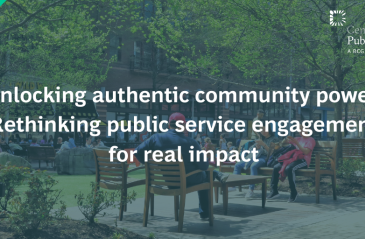
The power of storytelling in climate leadership

Cape Town's Strategic Policy Unit is refocusing the city’s governance
Share articleThe unit focuses on strategic and policy advice to the city’s government leaders
Share articleCape Town has established partnerships with international organisations such as the World Bank
Share articleWe put our vision for government into practice through learning partner projects that align with our values and help reimagine government so that it works for everyone.
Cape Town. Two words that summon countless images - from the glory of Table Mountain to Robben Island to the buzzing V&A Waterfront to the winelands that reside just beyond city limits. It's quite a list - one that draws visitors from near and far.
But look away from the tourist hot spots and it is clear that the city is not without its share of problems. Urban sprawl, high levels of crime crime, and infrastructure issues continue to plague local government leaders. The last is immediately evident to those arriving at the city's airport - the lack of a high-speed train link so common in other major cities comes as something of a surprise to the first-time visitor.
Such challenges help explain why Cape Town's mayor, Patricia de Lille, wasted little time after her election in 2011 to set up a Strategic Policy Unit (SPU) to refocus the city's governance around strategic policy planning, performance monitoring and evaluation. Its task was to identify problems in policy implementation and drive strong delivery of her administration's objectives across the city.
Taru Jaroszynski, the previous manager of the SPU, says that its creation was itself something of a novelty. “The mayor was determined to use her time in post to create a modern, well-run city,” she points out. “And although a similar structure existed in Johannesburg, this was quite an innovative approach for local government. There is a fair amount of decentralisation in South Africa but the main issue is about capacity - which is quite often lacking. But in Cape Town we were able to roll out a number of different programmes, all focused on outcomes and driving strong improvements for the city's citizens.”
The SPU was designed and modelled in the city by its first director, Craig Kesson, and sought inspiration in its structure from Sir Michael Barber's Delivery Unit in Downing Street.
“It initially started as a small and flexible operation but over the years that I was there it grew and took on a bigger project management focus,” she explains. “We had a number of high-level strategic management teams - we called them ‘transversal work groups' - and we would deliver key strategic projects through them. They could work on anything from individual issues such as facilities management and substance abuse cases through to groups that looked at service delivery more broadly.”
In essence, though, the SPU had three main aims. “The first was strategic and policy advice to the city's government leaders - including the mayor, city manager and departmental directors,” explains Jaroszynski. “The second was to monitor performance on behalf of the leadership. This led to the design and roll-out of what we called the ‘mayoral dashboard' - which was partly designed on PEMANDU's monitoring system in Malaysia, as well as Baltimore's CitiStat work. And the third was the specific project management work, which slowly became more and more important.”
This trio of pillars was designed to ensure the successful coordination and delivery of key strategic projects, as well as to address departmental silos - and successes were many. For example, in addition to the individual delivery projects, the role of a transversal management system was successfully implemented across the city's local government. Partnerships were also established with international organisations such as UNICEF and the World Bank, and Jaroszynski herself led a multidisciplinary team using design methodologies to look at how to address violence against women in public spaces.
Another highlight was the SPU's progress in facilitating deeper collaborations with the private sector - a task they accomplished using existing tax law. “I was involved in writing a social development strategy and one of the areas we identified was a need for greater collaboration between the public and private sectors, as well as NGOs and civil society,” she explains. “Unfortunately, at the time the ability to facilitate this type of collaboration in local government was difficult. Staff also felt a bit nervous at the prospect - they were unsure about where the boundaries would be and the mindset in general was one of anxiety about this type of innovation.”
The SPU, though, was not to be rebuffed. Rather than accept the status quo, Jaroszynski's team conducted an extensive audit of the issues that affected these different sectors. This was done in order not only to strengthen their understanding of ongoing challenges but also to identify the potential benefits of what greater collaboration might bring.
“From this piece of work we managed to get the heads of different local government departments - like legal and supply chain management - into a room to discuss how to break down barriers and work more closely together,” she recalls. “This led to a new project that looked at how to facilitate contributions from the private sector to government. We actually registered government as a ‘public benefit organisation', which meant that we were classified the same as NGOs or non-profit organisations. This ensured that any donation to the government for a public good could be tax-deductible. It was a bit of a loophole in the tax law but there is no doubt that the way we used it benefited the city and its citizens.”
Jaroszynski now lives and works in the UK, but she is still proud to have been part of the team and the approach of focusing on delivery and performance. In a way, the hard work - getting it set up and accepted - is complete and now the focus is full bore on delivering Mayor de Lille's array of priorities.
“Remember that South Africa's democracy is relatively new,” concludes Jaroszynski. “And our system of local government is even younger, having come in six years later. But in governments - state, local, federal and around the world - there is always a sense of uncertainty when it comes to trying anything new or different. But the results and impact of this strategic delivery approach speak for themselves.”











